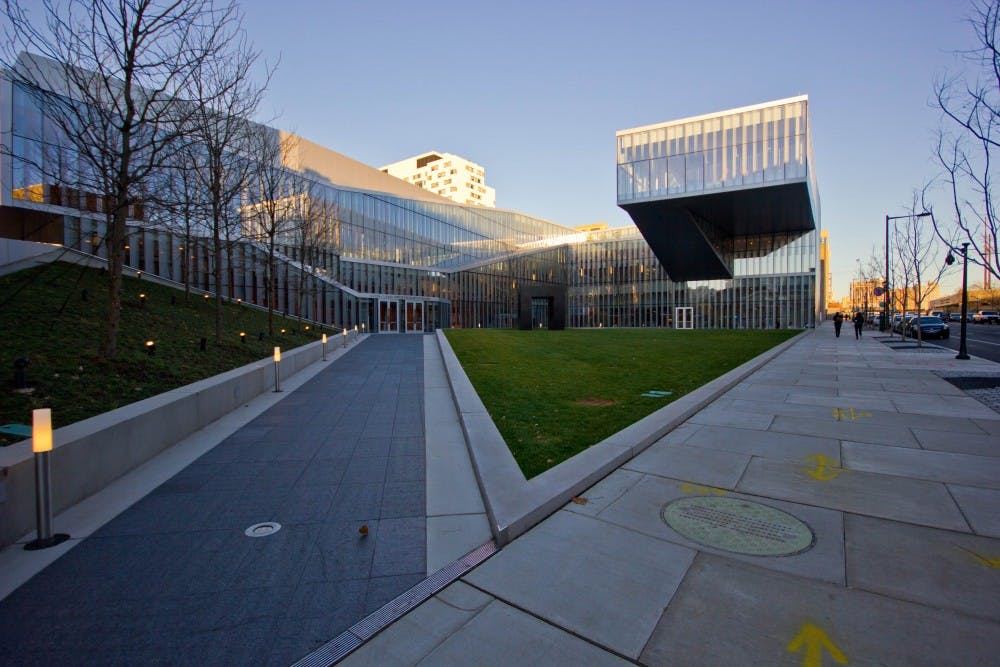
Since 2008, Penn has spent invested heavily in new research buildings such as the Singh Center for Nanotechnology.
Credit: Luke Chen , Luke ChenFor research institutions, it’s publish or perish — and Penn certainly isn’t perishing.
The White House Office of Science and Technology announced plans Monday to increase research funding across the board for the 2016 fiscal year. This would bolster Penn’s research efforts. It would also deepen Penn’s pockets — research funding makes up one third of Penn’s revenue.
Penn’s Office of the Vice Provost of Research, however, is skeptical that the federal government will actually increase funding. “The realistic picture is that once this gets through Congress, those increases aren’t going to be across the board,” Director of Research Initiatives Marc Rigas said.
Even without increased federal funding, however, Penn is positioned to expand its research at an unprecedented rate over the coming years.
Despite recent cuts in federal funding promoted by the government sequester, Penn received more research grants in 2011 — $707 million — than any other Ivy League university. In 2012, Penn had the second highest total research and expenditures among the Ivies, ranking in the top 2.8 percent of American universities.
Penn has been so successful at securing research dollars that gains were highlighted as a source of financial boon for the University in the 2014 Annual Financial Report.
“Despite downward pressures on federal sponsored research funding, research-related revenues totaled $881 million and for the first time since FY 2010 — the height of the American Recovery and Reinvestment Act (ARRA) stimulus program — new award dollars exceeded expenditures,” Vice President for Finance & Treasurer Stephen Golding wrote in the report’s introduction.
These gains haven’t happened by chance.
“If the pie is shrinking, one of the things we can do to remain a meaningful participant in the research realm here is to grow our market share,” Golding said. To do so, Penn has realigned its efforts to spur research at Penn in three ways.
First, Penn has invested in infrastructure development. Since 2008, it has spent heavily on new research buildings, equipment and translational research centers and launched the Singh Center for Nanotechnology, among other new facilities. It has also invested in research faculty to bring the best and brightest to Penn labs.
Second, Penn has pivoted its research strategy away from relying entirely on government funding and is now focusing on attracting funding from nonprofits and corporations through commercialization efforts.
“The other way is to diversify our funding sources,” Golding said. “A big part of what helps us support our research infrastructure is actually funded through commercialization of some of the intellectual property that emanates from some of the research that we do.”
Finally, Penn is building the South Bank campus in an effort to promote innovation. “The acquisition of what we call Pennovation Works gives us the lynchpin to promote some of Penn’s research and commercialization, invest in some Penn’s startup technologies and companies,” Golding said.
While Penn’s research program has flourished, those of other Ivy League universities have floundered. At Brown, the total pool of research funds at the University decreased by 13.7 percent between 2013 and 2014, the Brown Daily Herald reported in an article on Tuesday.
Following the sequester, Yale professors scrambled to find funding, as well. “We don’t fully know the effect yet, but it seems like it’s harder to get grant applications accepted, and grant approvals are being reduced in what they award,” Provost Benjamin Polak told the Yale Daily News.
These schools are not alone.
“Candidly, other big research institutions, I’ll use the word competitors, have seen their success rate on grant proposals fall significantly,” Golding said. “We seem to be doing a good job in making the kind of investments that are going to create good, strong research that has appeal to peer reviewed panels.”
Vice President of Budget and Management Analysis Bonnie Gibson says this has more to do with the efforts of individual schools than overall University policy. “The budgets are actually bottom up. So each school is looking at its portfolio and saying what’s going to happen to research and how am I going to compensate,” she said. “If you don’t get the grant, you don’t get the expense,” and each school has to manage accordingly, she said.
One school has dealt particularly well.
“The School of Medicine, which does the lion share of our research has done a remarkable job of maintaining a pretty solid base of research and actually are anticipating research growth even in the face of declining federal funding,” Gibson said.
Other schools including the School of Engineering and Applied Science and School of Arts and Sciences have also been particularly resilient, according to Provost Vincent Price, because researchers have been able to tap into an increased national emphasis on material science engineering and energy-related research and tailor their proposals to win those new grants.
Penn plans to continue their emphasis on research. It can only hope that Congress will follow suit.
The Daily Pennsylvanian is an independent, student-run newspaper. Please consider making a donation to support the coverage that shapes the University. Your generosity ensures a future of strong journalism at Penn.
DonatePlease note All comments are eligible for publication in The Daily Pennsylvanian.




